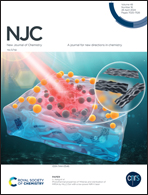Peptide-linked perylenebisimide and ferrocene dicarboxylic acid conjugates with tunable optoelectronic properties†
Abstract
Water soluble, cationic charge, peptide appended perylenebisimide (PBI-CFK) has been designed, synthesized, purified, and fully characterized. A hybrid system has been composed with PBI-CFK and oppositely charged deprotonated ferrocenedicarboxylic acid (Fc). In this case, PBI-CFK acts as an acceptor and Fc as a donor. The UV-visible study reveals the blue shift of PBI-CFK absorption and its photoluminescence intensity is gradually quenched upon the addition of Fc upto 1 equivalent. HR-TEM (high-resolution transmission electron microscopy) studies exhibit highly ordered and more condensed structures of the hybrid system than those of each of these components. The current–voltage (I–V) study clearly shows that the hybrid provides better semiconducting properties compared to PBI-CFK, which appears to be due to the electronic and ionic interaction of these two components. Here, PBI-CFK exhibits photoswitching properties with a photocurrent gain (Ion/Ioff) of 2.04, whereas the hybrid shows a significant improvement of the photoswitching properties with the photocurrent gain (Ion/Ioff) of 4.04 and this is about twice that of the individual one. Thus, the formation of a donor–acceptor conjugate between Fc and PBI-CFK results in modulation of the optoelectronic and photoswitching properties.



 Please wait while we load your content...
Please wait while we load your content...